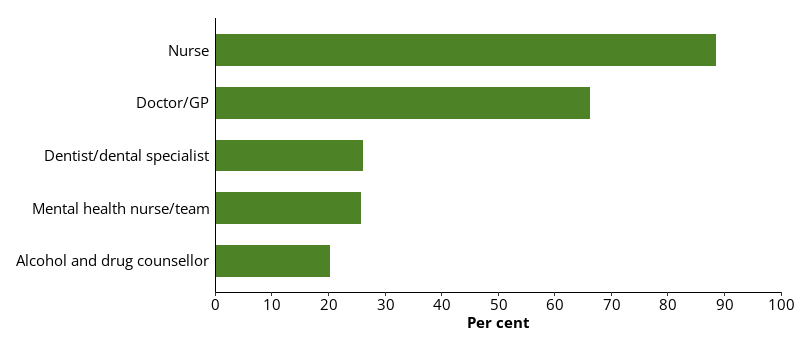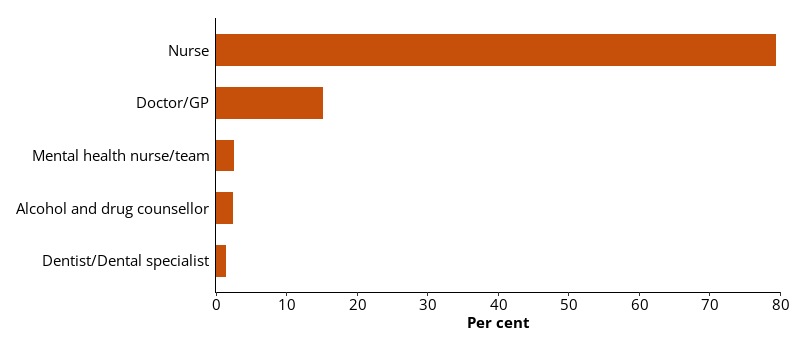Initiator of clinic visits
As happens in general practice in the community, a visit to the prison clinic may be initiated by the patient or by clinic staff.
A patient initiating a clinic contact indicates health-care-seeking behaviour. A health professional may initiate clinic contacts, for example, to monitor a health condition, to follow up a pathology test, or for health intervention. During the 2-week data collection period, clinicians indicated on the clinic visit form whether the visit had been initiated by the patient or by staff.
More than 1 in 3 (36%) clinic visits were initiated by the patient (Indicator 3.1.14).
About 3 in 5 (63%) clinic visits recorded during the data collection period were initiated by clinic staff.
Patient-initiated visits were similar for males and females (36%), as well as for non‑Indigenous (37%) and First Nations patients (35%).
All age groups were similarly as likely to initiate a clinic visit. Patients aged 25–34 (38%) were the most likely to initiate a clinic visit, and those aged 45 and over were the least likely (34%).
Type of health professional seen
Prison clinics usually have nurse-led health care, with nurses responsible for providing most of a patient’s primary health care through the prison clinic. If nursing staff are unable to help a patient, they can refer them to a doctor, allied health professional, or other health specialist, either in the prison clinic, or outside the prison.
Most prison clinics have doctors/GPs who either work at the prison or visit regularly. Prisons often offer other health services, such as dental services, mental health services, and alcohol and other drug treatment services.
Type of health professionals seen by prison dischargees
Prison dischargees were asked which type of health professionals they had seen in prison. Of prison dischargees who saw a health professional in the prison clinic:
- almost 9 in 10 (89%) reported seeing a nurse
- 2 in 3 (66%) reported seeing a doctor/GP
- about one-quarter (26%) reported seeing a dentist
- about one-quarter (26%) reported seeing a mental health team
- 1 in 5 (20%) reported seeing an alcohol and other drug counsellor (Figure 10.10).
Figure 10.10: Prison dischargees, self-reported type of health professional seen in the prison clinic, 2022

Notes
- Proportions are representative of this data collection only, and not the entire prison population.
- Excludes Victoria, which did not provide data for this item.
Source: Dischargees form, 2022 NPHDC
Type of health professional seen by people in custody
The type of health professional who provided the service for each clinic visit was recorded on the clinic visit form.
The clinic visit form was completed for clinic visits attended by all consenting people in custody during the 2-week data collection period – not just for clinic visits by prison dischargees. So information from this form provided types of health professionals seen by a larger proportion of the prison population.
The majority of clinic visits recorded during the 2-week data collection period (80%) were consultations with nurses. One in 7 (15%) clinic visits were consultations with a doctor/GP, 2.6% with a mental health nurse/team, 2.5% with an alcohol and drug counsellor and 1.5% with a dentist/dental specialist (Figure 10.11).
Psychologists, psychiatrists, physiotherapists, Indigenous health workers, medical imaging professionals, social workers and other health professionals combined accounted for about 1 in 13 (8.0%) of all clinic visits recorded during the data collection period.
Figure 10.11: Type of health professionals conducting clinic visits, 2022

Notes
- Proportions are representative of this data collection only, and not the entire prison population.
- Excludes New South Wales, which did not provide data for this item.
Source: Clinic form, 2022 NPHDC.


